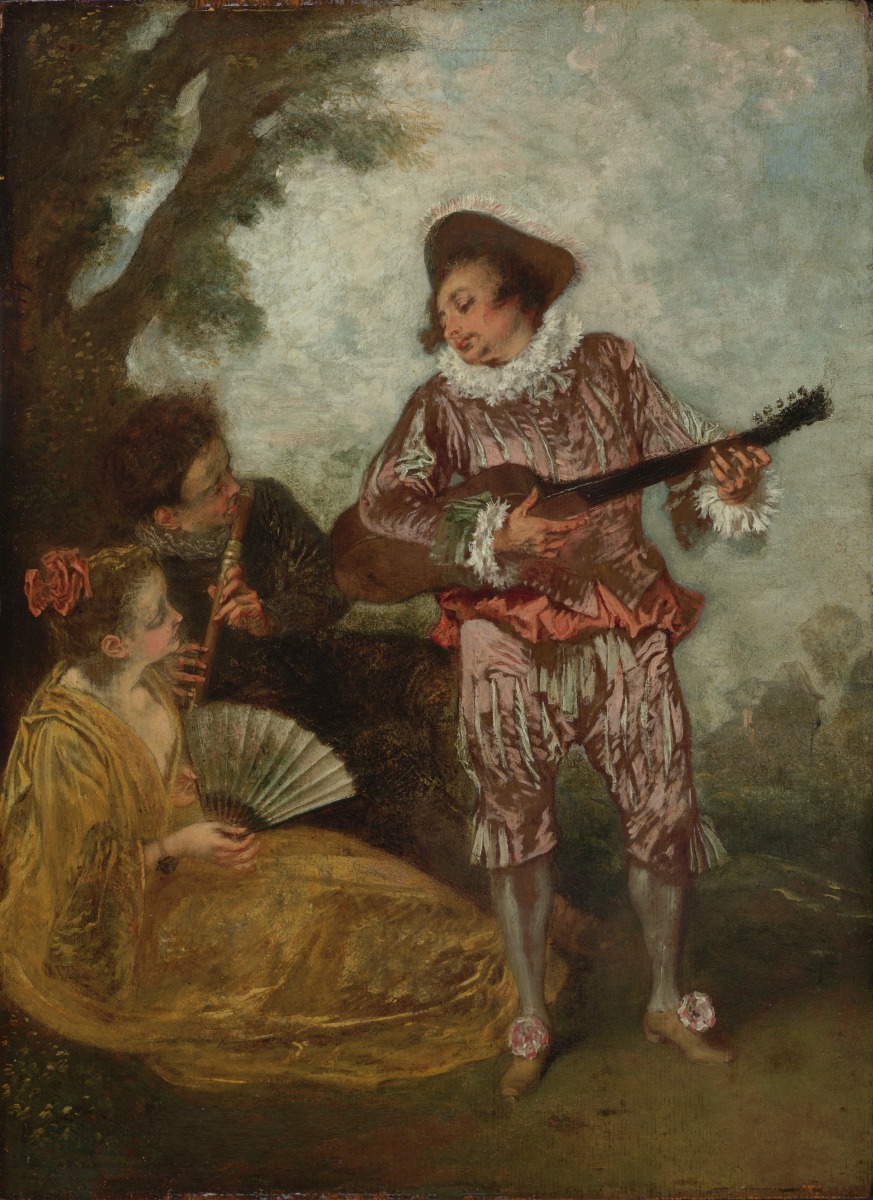
The Gazer (Le Lorgneur) (Primary Title)
Jean-Antoine Watteau, French, 1684 - 1721 (Artist)
Watteau’s colorful palette, sketch-like brushwork, and wistful tableaus were so different from the academic paintings usually accepted by the French Academy that it created a new term, fête galante, to describe his works. This new genre offered tantalizing, dreamlike glimpses into the amorous amusements of elegantly attired French aristocrats, usually set within a garden or park.
In this idyllic scene, a young man in a striped, shimmering costume strums a guitar as he gazes at a young woman toying with a fan. Behind them, the flute player leans toward the woman but keeps his eyes on his fellow player. Watteau frequently included stock characters from popular theater productions in his scenes, which sometimes leaves viewers wondering whether these figures are actors playing aristocrats or aristocrats emulating actors. The woman and two male performers in Serenade near a Fountain, a painting by Jacques de Lajoüe also on this wall, were probably inspired by the trio of figures in this work.
The Age of Elegance and Grandeur, Artmobile, Virginia Museum of Fine Arts, Richmond, VA, September 1967 - June 1968
La Peinture Francaise dans les Collections Americaines, Gallerie des Beaux-Arts, Bordeaux, France, May - September 1966
The Human Form in Art, California Palace of the Legion of Honor, DeYoung Museum and San Francisco Museum, November 10, 1964 - January 3, 1965
Les Fêtes Galantes, Virginia Museum of Fine Arts, Richmond, VA, January 20 - March 5, 1956
Guildhall Exhibition, London, 1902 and 1904
[1] Confirmed by 1727 engraving by Scotin. See Emile Dacier and Albert Vauflart, Jean de Julienne et les graveurs de Watteau au 18e siecle. Paris: Société pour l'étude de la gravure française, 1929; and Jean Levy, "Watteau's 'Le Lorgneur,'" The Burlington Magazine 96, no. 616 (July 1954): 197-202.
[2] Coypel is believed to have acquired the painting between 1727 and 1731. The painting was sold after his death. Levy cites the sale taking place in April 1753. It is unknown who purchased the painting at the Coypel sale. See Jean Levy, "Watteau's 'Le Lorgneur,'" The Burlington Magazine 96, no. 616 (July 1954), 198.
[3] Anonymous sale on February 20, 1797. This sale may have been followed by two additional anonymous sales, in 1828 and again in 1831. Unconfirmed; listed on an unattributed, undated document in object file. See VMFA Curatorial file.
[4] Probably Charles Auguste Louis Joseph de Morny, also known as Duke de Morny [1811-1865]. The painting was sold through unknown dealer on May 24, 1852, according to undated document written by A. Wertheimer. See VMFA Curatorial file.
[5] Name as it appears in the sale catalogue. Thought to be the Francophone spelling of the name Nieuwenhuys, according to A. Wertheimer. See VMFA Curatorial file.
[6] Unconfirmed. Listed on undated, unattributed document in the object file, but not included on object card. See VMFA Curatorial file.
[7] E. Cronier is believed to have sold the painting in December of 1905. See Jean Levy, "Watteau's 'Le Lorgneur,'" The Burlington Magazine 96, no. 616 (July 1954), 198; and VMFA Curatorial file.
[8] The VMFA object card denominates the owner as a Joseph Darmon; unattributed and undated document in the object file names the owner as Jean Darmon. See VMFA Curatorial and Registration files.
[9] Accessioned June 9, 1955.
Some object records are not complete and do not reflect VMFA's full and current knowledge. VMFA makes routine updates as records are reviewed and enhanced.
